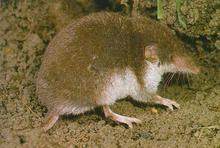Borna disease (BD) is a fatal neurologic disorder in horses and sheep. The etiologic agent, Borna disease virus (BDV), belongs to the order Mononegavirales, which is composed of many reservoir-bound, highly pathogenic, and zoonotic viruses.

A bicolored shrew - Linked to fatal neurologic disorder in horses
Scientists investigated bicolored white-toothed shrews to determined whether the Borna disease virus infections in small mammals might have different disease courses and whether shrew-to-horse virus transmission occurs.
© 2013 by Dodoni
To investigate whether small mammals, especially bicolored white-toothed shrews, which act as BDV reservoirs in Switzerland, harbor BDV in disease-endemic areas in Bavaria, Germany, scientists screened 120 small mammals. They also determined whether BDV infections in small mammals might have different disease courses and whether shrew-to-horse virus transmission occurs.
The small mammals were captured during pest control efforts in stables in Upper Bavaria and Swabia that had a history of acute equine BD during 1997 - 2012. These stables also had a high probability for presence of C. leucodon shrews as documented by a recent distribution model.
BDV-specific serum antibodies were identified by using an indirect immunofluorescence test and blood samples or thoracic or abdominal effusions as described (4). Antibodies against BDV were found in 8/105 specimens.
Histologic and immunohistochemical (IHC) analyses for detection of BDV antigen were performed for small mammals that had antibodies against BDV or BDV RNA. In addition, histologic and IHC analyses were used to test 36/112 small mammals negative for BDV. None of the small mammals showed obvious gross or histologic lesions, even in the brain.
IHC analysis was performed by using monoclonal antibody Bo18 against BDV nucleoprotein (BDV-N) as described (7). The 2/2 C. leucodon shrews (#2001 and #5017) harboring viral RNA had BDV antigen in the central and peripheral nervous system (brain, spinal cord, spinal trigeminal ganglia, and peripheral nerves). Immunostaining of the skin showed evidence of BDV infection, mainly in epidermal keratinocytes and sebaceous glands, as well as in squamous epithelium and connective tissue of the esophagus. In shrew #5017, renal tubuli and glomeruli, as well as nuclei of bronchiolar epithelial cells, had BDV-N. No evidence for viral antigen was found in the other 42/44 small mammals tested.
In conclusion, BDV RNA, viral antigen, and serum antibodies against BDV were detected in 2/20 C. leucodon shrews, indicating that this shrew is reservoir of BDV in Bavaria.
Whether seropositivity without other evidence of BDV infection indicates different courses of infection in small mammals, as known for horses, is not known and warrants further investigation. The absolute homology of shrew and equine BDV suggests successful interspecies virus transmission. This study provides reliable evidence that C. leucodon shrews acts as reservoirs for BDV in disease-endemic areas in Bavaria, Germany, argues for a general role of this shrew as a reservoir for mammalian bornaviruses.
Report by researchers: Manon Bourg, Sibylle Herzog, Jorge A. Encarnação, Daniel Nobach, Hildburg Lange-Herbst, Markus Eickmann, and Christiane Herden [Comments to Author]
Author affiliations: Justus-Liebig-University, Giessen, Germany (M. Bourg, S. Herzog, J.A. Encarnação, D. Nobach, H. Lange-Herbst, C. Herden); Philipps University, Marburg, Germany (M. Eickmann)
Edited from article on CDC website accessed 12/01/2013
